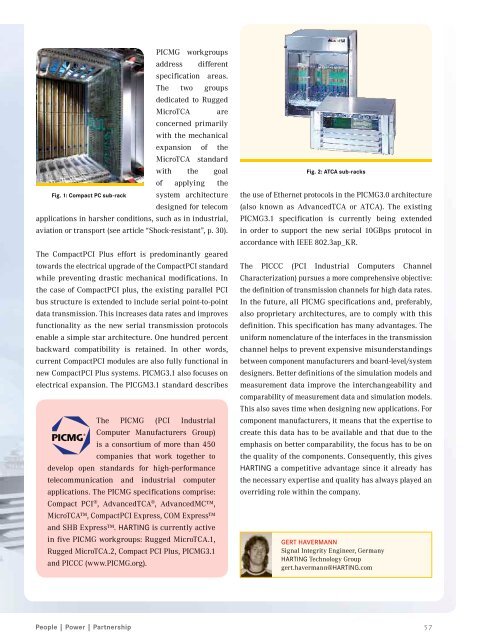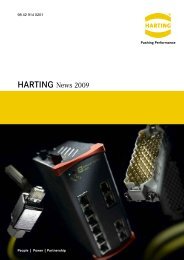Download - Harting
Download - Harting
Download - Harting
You also want an ePaper? Increase the reach of your titles
YUMPU automatically turns print PDFs into web optimized ePapers that Google loves.
Fig. 1: Compact PC sub-rack<br />
PICMG workgroups<br />
address different<br />
specification areas.<br />
The two groups<br />
dedicated to Rugged<br />
MicroTCA are<br />
concerned primarily<br />
with the mechanical<br />
expansion of the<br />
MicroTCA standard<br />
with the goal<br />
of applying the<br />
system architecture<br />
designed for telecom<br />
applications in harsher conditions, such as in industrial,<br />
aviation or transport (see article “Shock-resistant”, p. 30).<br />
The CompactPCI Plus effort is predominantly geared<br />
towards the electrical upgrade of the CompactPCI standard<br />
while preventing drastic mechanical modifications. In<br />
the case of CompactPCI plus, the existing parallel PCI<br />
bus structure is extended to include serial point-to-point<br />
data transmission. This increases data rates and improves<br />
functionality as the new serial transmission protocols<br />
enable a simple star architecture. One hundred percent<br />
backward compatibility is retained. In other words,<br />
current CompactPCI modules are also fully functional in<br />
new CompactPCI Plus systems. PICMG3.1 also focuses on<br />
electrical expansion. The PICGM3.1 standard describes<br />
The PICMG (PCI Industrial<br />
Computer Manufacturers Group)<br />
is a consortium of more than 450<br />
companies that work together to<br />
develop open standards for high-performance<br />
telecommunication and industrial computer<br />
applications. The PICMG specifications comprise:<br />
Compact PCI®, AdvancedTCA®, AdvancedMC,<br />
MicroTCA, CompactPCI Express, COM Express<br />
and SHB Express. HARTING is currently active<br />
in five PICMG workgroups: Rugged MicroTCA.1,<br />
Rugged MicroTCA.2, Compact PCI Plus, PICMG3.1<br />
and PICCC (www.PICMG.org).<br />
Fig. 2: ATCA sub-racks<br />
the use of Ethernet protocols in the PICMG3.0 architecture<br />
(also known as AdvancedTCA or ATCA). The existing<br />
PICMG3.1 specification is currently being extended<br />
in order to support the new serial 10GBps protocol in<br />
accordance with IEEE 802.3ap_KR.<br />
The PICCC (PCI Industrial Computers Channel<br />
Characterization) pursues a more comprehensive objective:<br />
the definition of transmission channels for high data rates.<br />
In the future, all PICMG specifications and, preferably,<br />
also proprietary architectures, are to comply with this<br />
definition. This specification has many advantages. The<br />
uniform nomenclature of the interfaces in the transmission<br />
channel helps to prevent expensive misunderstandings<br />
between component manufacturers and board-level/system<br />
designers. Better definitions of the simulation models and<br />
measurement data improve the interchangeability and<br />
comparability of measurement data and simulation models.<br />
This also saves time when designing new applications. For<br />
component manufacturers, it means that the expertise to<br />
create this data has to be available and that due to the<br />
emphasis on better comparability, the focus has to be on<br />
the quality of the components. Consequently, this gives<br />
HARTING a competitive advantage since it already has<br />
the necessary expertise and quality has always played an<br />
overriding role within the company.<br />
Gert Havermann<br />
Signal Integrity Engineer, Germany<br />
HARTING Technology Group<br />
gert.havermann@HARTING.com<br />
57





